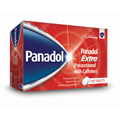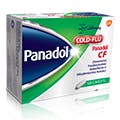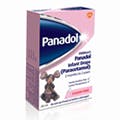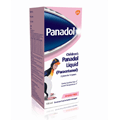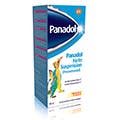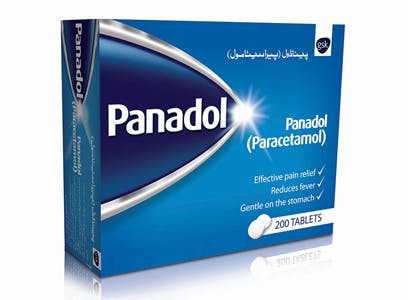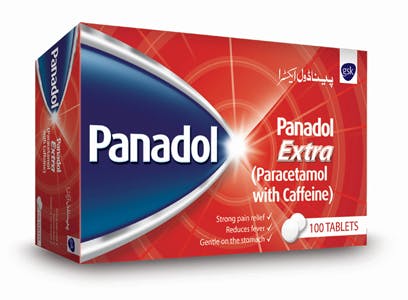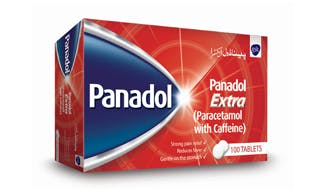

Panadol Regular

Panadol Extra

Panadol Extra

Panadol CF

Panadol Drops

Panadol Liquid

Forte Suspension
Compare Now (0/5)
- Product
- Format
- Age
- Key Features
- Ingredients


Panadol Regular
- Tablets
- 12+ Years
- Trusted Pain Relief
- 500mg Paracetamol
- No gluten, lactose or sugar

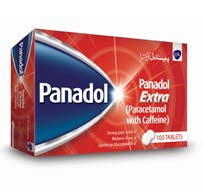
Panadol Extra
- Tablets
- 12+ Years
- Fights Tough Pain
- Active Ingredient: Paracetamol 24 mg/mL


Panadol Extra
- Tablets
- 12+ Years
- Fights Tough Pain
- Active Ingredient: Paracetamol 24 mg/mL


Panadol CF
- Tablets
- +12 Years
- Cold Relief
- Active ingredient: Paracetamol 125mg per suppository.

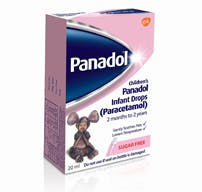
Panadol Drops
- Liquid
- 1 Month - 5 Years
- Gentle on Tiny Tummies
- Active ingredient: Paracetamol 24 mg/mL

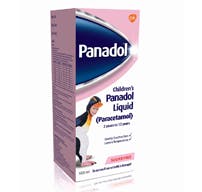
Panadol Liquid
- Liquid
- 1-5 Years
- Fast & gentle relief
- Active ingredient: Paracetamol 24 mg/mL


Forte Suspension
- Liquid
- 7+ Years
- When oral dose isn't suitable
- Active ingredient: 250mg Paracetamol per suppository
Minimise
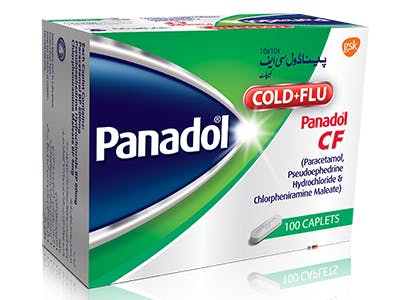
Adult's Panadol
Panadol CF
Panadol CF contains a combination of an antipyretic/analgesic, a decongestant and an antihistamine
Overview
- Common cold
- Influenza
- Fever associated with common cold and flu
- Muscle ache
- Nasal congestion
- Sinus congestion
- Headache and sinus pain
- Sneezing
- Itchy and watery eyes
- Available in tablet format
- Provides relief from symptoms of cold and flu
- Helps with nasal congestion
- Paracetamol BP 500mg
- Pseudoephedrine Hydrochloride BP 60 mg
- Chlorpheniramine Maleate BP 4mg
Overview
How To Use
For oral administration only. Always read the label before use.

Dosage
Adults and children over 12 years:
o One caplet every 4-6 hours as needed.
Children under 12 years:
o Do not give to children under 12 years of age.
Maximum dosage: 4 caplets in 24 hours.
Minimum dosing interval: 4 hours.
Do not exceed the stated dose or frequency of dosing.
Should not be used with other products containing paracetamol, decongestants or antihistamines, including cough and cold preparation.
Use only under medical advice if symptoms persist for more than 7 days.
The lowest dose necessary to achieve efficacy should be used, users should be advised to seek medical advice if symptoms persist for more than 7 days.

Warnings and Precautions
Contains paracetamol. Do not use with any other paracetamol-containing products, decongestants, antihistamines or cold and flu medicines. The concomitant use with other products containing paracetamol may lead to an overdose. Paracetamol overdose may cause liver failure which can lead to liver transplant or death.
Caution should be exercised in patients with mild to moderate kidney impairment and in those with hepatic impairment. Underlying liver disease increases the risk of paracetamol-related liver damage.
Cases of hepatic dysfunction/failure have been reported in patients with depleted glutathione levels, such as those who are severely malnourished, anorexic, have a low body mass index or are chronic heavy users of alcohol.
Caution should be exercised in patients with cardiovascular disease, arrhythmias, hypertension, hyperthyroidism, prostatic enlargement, diabetes, glaucoma, phaeochromocytoma, epilepsy, bronchitis, bronchiectasis and bronchial asthma.
Caution should be exercised in patients with glutathione depleted states such as sepsis, the use of paracetamol may increase the risk of metabolic acidosis.
There have been reports of ischaemic colitis with pseudoephedrine. Pseudoephedrine should be discontinued immediately and medical advice sought if sudden abdominal pain, rectal bleeding or other symptoms of ischaemic colitis develop.
There have been rare cases of posterior reversible encephalopathy (PRES)/reversible cerebral vasoconstriction syndrome (RCVS) reported with sympathomimetic drugs, including pseudoephedrine. Symptoms reported included sudden onset of severeheadache, nausea, vomiting, and visual disturbances. Most cases improved or resolved within a few days following appropriate treatment. Psuedoephedrine should be discontinued immediately and medical advice sought if signs/symptoms of PRES/RCVS develop.
The anticholinergic properties of chlorphenamine may cause drowsiness, dizziness, blurred vision and psychomotor impairment in some patients which may seriously affect ability to drive and use machinery.
Chlorphenamine may increase the effects of alcohol and therefore concurrent use should be avoided.
Concurrent use with drugs which cause sedation, such as anxiolytics and hypnotics may cause an increase in sedative effects, therefore medical advice should be sought before taking chlorphenamine concurrently with these medicines.
Use with caution in patients taking beta-blockers or other anti-hypertensives.
Children and the elderly are more likely to experience neurological anticholinergic effects and paradoxical excitation (e.g. increased energy, restlessness, nervousness).
If symptoms persist, medical advice must be sought.
Keep out of sight and reach of children.

Overdose
Paracetamol
Sign & Symptoms - Paracetamol overdose may cause liver failure which can lead to liver transplant or death. Acute pancreatitis has been observed, usually with hepatic dysfunction and liver toxicity.
Treatment – Immediate medical management is required in the event of overdose, even if symptoms of overdose are not present
Administration of N-acetylcysteine or methionine may be required.
Pseudoephedrine
Pseudoephedrine overdose may result in symptoms due to central nervous system and cardiovascular stimulation e.g. excitement, restlessness, hallucinations, hypertension and arrhythmias. In severe cases, psychosis, convulsions, coma and hypertensive crisis may occur. Serum potassium levels may be low due to extracellular to intracellular shifts in potassium.
Treatment should consist of standard supportive measures. Beta-blockers should reverse the cardiovascular complications and the hypokalemia.
Chlorphenamine
Symptoms and Signs – Overdose is likely to result in effects similar to those listed under adverse reactions. Additional symptoms may include paradoxical excitation, toxic psychosis, convulsions, apnoea, dystonic reactions and cardiovascular collapse including arrhythmias.
Treatment – Treatment should be supportive and directed towards specific symptoms. Convulsions and marked CNS stimulation should be treated with parenteral diazepam.

Drug Interactions
The anticoagulant effect of warfarin and other coumarins may be enhanced by prolongedregular daily use of paracetamol-containing products with increased risk of bleeding;occasional doses have no significant effect.
Concomitant administration of pseudoephedrine hydrochloride-containing products andMAOIs (or within two weeks of stopping of MAOI) may lead to hypertensive crisis. Theanticholinergic effects of chlorphenamine are intensified by MAOIs.
Concomitant use of this medication with sympathomimetic agents (such asdecongestants, appetite suppressants and amphetamine-like psychostimulants) which interfere with the catabolism of sympathomimetic amines, may occasionally cause a rise in blood pressure (see Contraindications).
Pseudoephedrine-containing products may antagonise the effect of certain classes ofantihypertensives (e.g. beta blockers, methyl-dopa, reserpine, debrisoquine, guanethidine).
Concurrent use of chlorphenamine and hypnotics or anxiolytics may potentiatedrowsiness. Concurrent use of alcohol may have a similar effect.
Chlorphenamine inhibits phenytoin metabolism and can lead to phenytoin toxicity.

Contraindications
This product is contraindicated in patients:
with a previous history of hypersensitivity to paracetamol, pseudoephedrine, chlorphenamine, other antihistamines or excipients.
with severe hypertension or severe coronary artery disease.
who are receiving other sympathomimetics (such as decongestants, appetite suppressants and amphetamine-like psychostimulants).
who are receiving Monoamine Oxidase Inhibitors (MAOIs), or for two weeks after stopping a MAOI drug.
with severe renal impairment.

Pregnancy
This product should not be used during pregnancy unless considered essential by a physician.
Safe use of pseudoephedrine in pregnancy has not been established despite widespread use over many years. Caution should therefore be exercised by balancing the potential benefit of treatment to the mother against any possible hazards to the developing foetus.
There are no adequate data from the use of chlorphenamine maleate in pregnant women. The potential risk for humans is unknown. Use during the third trimester may result in reactions in the newborn or premature neonates.

Lactation
This product should not be used whilst breastfeeding unless considered essential by a physician.
Pseudoephedrine is excreted in breast milk in small amounts but the effect of this on breast fed infants is unknown.
Chlorphenamine maleate and other antihistamines may inhibit lactation and may be secreted in breast milk.

Ability to Perform Task that requires Judgement, motor, or cognitive skills
The anticholinergic properties of chlorphenamine may cause drowsiness, dizziness, blurred vision and psychomotor impairment in some patients which may seriously affect ability to drive and use machinery.

Adverse events
Paracetamol
Thrombocytopaenia, Anaphylaxis cutaneous hypersensitivity reactions including amoung others skin rashes, angiodema, stevens johnson syndrome, toxic epidermal necrosis, bronchospasm in patients sensitive to aspirin and other NSAIDs, hepatic dysfuction.
Phenylephrine
Nervousness, Headache, Dizziness, Insomnia, Increased blood pressure, Vomiting, nausea, Mydriasis, acute angle closure glaucoma, most likely to occur in those with closed angle glaucoma Tachycardia, Palpitations Allergic reactions (e.g. rash, urticaria, allergic dermatitis) Dysuria, urinary retention. This is most likely to occur in those with bladder outlet obstruction such as prostatic hypertrophy.
Chlorphenamine
Allergic reactions, angioedema, anaphylactic reactions Anorexia, Confusion*, excitation*, irritability*, nightmares*, Disturbance in attention, abnormal coordination, dizziness, headache Sedation, somnolence Blurred vision, Hypotension, Thickening of bronchial, Secretions, Nausea, dry mouth, Vomiting, abdominal pain, diarrhoea, dyspepsia, Exfoliative dermatitis, rash, urticaria, photosensitivity, Muscle twitching, muscle Weakness, Urinary retention, Fatigue, Chest tightness.
Enquiries
GSK is committed to the effective collection and management of human safety information relating to our products. If you need to report an adverse event or side effect with one of our products please send an email on pk_pharmasafety@gsk.com or call us at +92-21-111-475-725 between 9:00AM and 5:30PM on weekdays so we can give you more personalized attention.
Related Products
Format: Tablets
Key Features: Trusted Pain Relief
Effective For: Fever, Headache/Tension headache, Toothache, Migraine headache, Musculoskeletal pain, Osteoarthritis, Backache
Compare
Format: Tablets
Key Features: Trusted Pain Relief
Effective For: Headaches /Tension Headache, Migraine Headache, Osteoarthritis, Cold & Flu Symptoms, Period Pain, Muscular Aches, Sore Throat, Toothache
Compare
Related Products
Format: Tablets
Key Features: Trusted Pain Relief
Effective For: Fever, Headache/Tension headache, Toothache, Migraine headache, Musculoskeletal pain, Osteoarthritis, Backache
Compare
Format: Tablets
Key Features: Trusted Pain Relief
Effective For: Headaches /Tension Headache, Migraine Headache, Osteoarthritis, Cold & Flu Symptoms, Period Pain, Muscular Aches, Sore Throat, Toothache
Compare



